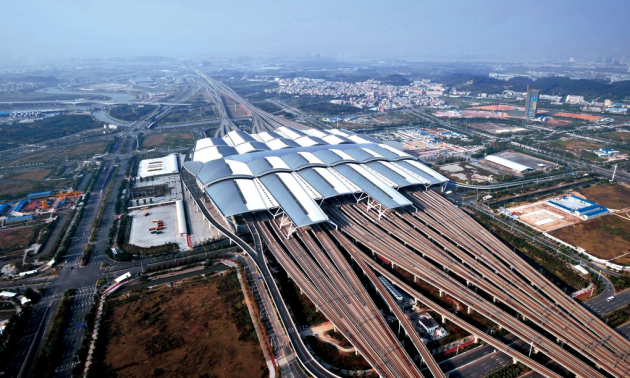China to add more than 11,000km of new high-speed lines by 2025
15 September, 2018

China’s “four vertical, four horizontal” high-speed railway grid has been taking shape at full speed, hitting a total system length of 27,000 kilometers – on which sleek bullet trains gallop at a speed of 250km/h – accounting for about two-thirds of the world’s high-speed rail tracks in commercial service.
China added 3,038km of new lines in 2017, and the total length is set to reach 38,000km in 2025.
Remember that the nation only commissioned its first high-speed line, the Beijing-Tianjin Intercity Rail, 10 years ago, in June 2008.
The world’s longest high-speed railway network is also the most extensively used one, with daily ridership nationwide hovering around the 3.5 million level. The advent of high-speed rail (HSR) is often hailed as a sign of China’s rejuvenation and a source of national pride.
The 27,000km high-speed rail network in service as of the end of 2017, on which trains travel at speeds of 250km/h. Photo: Handout
Notable HSR lines in China include the Beijing–Guangzhou High-Speed Railway, which at 2,298km is the world’s longest line of its kind in operation; the Beijing–Shanghai line, which has the world’s fastest operating conventional train services; and the Shanghai Maglev, the world’s first magnetic-levitation line, where trains glide from Pudong Airport to the city center and vice versa on a non-conventional track at a top speed of 430km/h.
China’s early high-speed trains were imported or built under technology-transfer agreements with foreign manufacturers including Alstom, Siemens, Bombardier and Kawasaki Heavy Industries. Chinese engineers have redesigned internal train components and built indigenous trains manufactured by the state-owned CRRC Corporation at its plants across the nation.
The interior of the new 370,000-square-meter station serving the central Chinese city of Wuhan. Photo: Xinhua
The Fuxing (Rejuvenation) series, the newest home-made bullet-train series with a top cruising speed of 380km/h. Photo: N509FZ/WikiMedia
A screen shows the top cruising speed of a bullet train running on the Shanghai-Ningbo line in eastern China. Photo: Weibo
Six high-speed lines, Beijing–Tianjin, Shanghai–Nanjing, Beijing–Shanghai, Shanghai–Ningbo, Shanghai–Nanjing and Guangzhou–Shenzhen–Hong Kong, have reported decent operational profitability over the years, and the Beijing–Shanghai service is particularly lucrative, reporting an annual net profit of no less than 8 billion yuan (US$1.16 billion).
A new “Mid-to-Long Term Railway Network” masterplan has also been finalized, for a larger 8+8 high-speed rail grid serving the nation and expanded intercity lines for regional and commuter services for large metropolitan areas. The proposed completion date for the network is 2030.
The total length of China’s railway network reached 127,000km by the end of last year. Electrified railways and double-track routes stood at 86,600km and 71,800km respectively.
An official with the China Railway Corp said more than half of the railways in use in the US had only one track and trains only traveled at around 150km/h on the country’s only high-speed railway between Washington, DC, and New York City.
